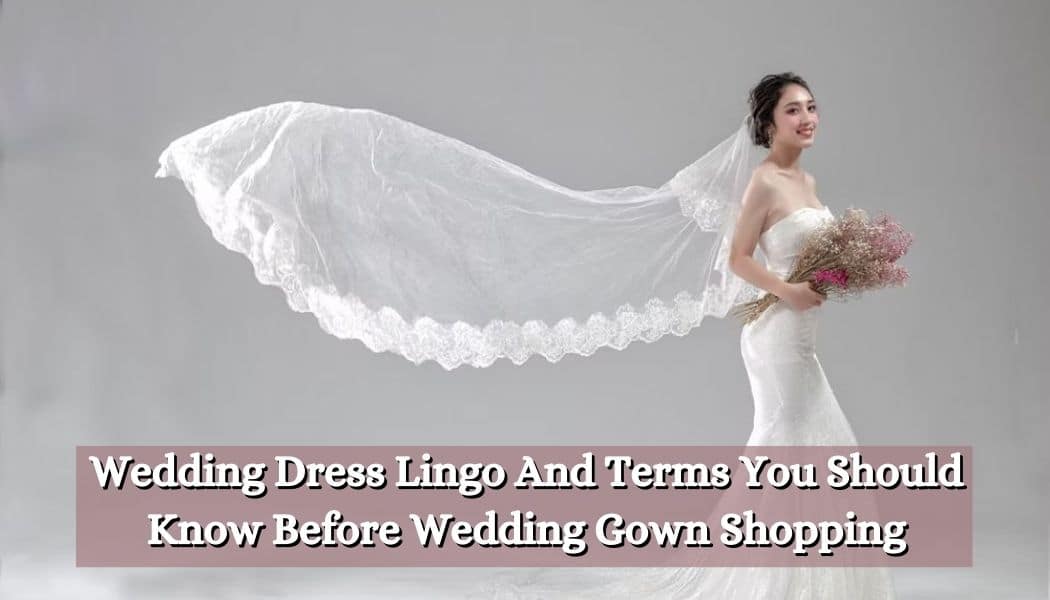
If you are newly engaged and beginning your research on wedding dresses, don’t be surprised if you are confused by terms like “fit and flare”, trumpet style, mermaid, etc. These are all words that commonly float around in bridal boutiques, those that you will hear during wedding dress shows and even see on blog pages like ours.
To be honest, this industry has its own language! Unless you’ve been following it closely, it can sound confusing and you may have no idea what the terms mean. But, as a soon-to-be bride, we think it is essential that you familiarize yourself with some of the most commonly used wedding terms before you go shopping. This will make you more comfortable and also allow you to understand what your bridal consultant means when she uses technical terms to define a dress. Trust us, it will save you from feeling overwhelmed at your dress appointment.
To save you the trouble of finding all these out by yourself, we have compiled the commonly used words from the wedding world here. This will allow you to describe the dress in your vision in crisp terms to your shop assistant, without having to just search through hundreds of dresses to find what you think you want.
Table of Contents
Wedding Dress Silhouettes
A silhouette basically refers to the way the dress drapes around your body. It is important to choose a silhouette that flatters your figure. When you choose the right one, you can highlight your best features and camouflage the less desirable features.
In the wedding world, the following are the most popular silhouettes that are used in dresses.
A-line: Also called princess-line, this dress resembles the letter “A.” It closely follows the body in the bodice and then flows outwards from the waist without looking too bulky.
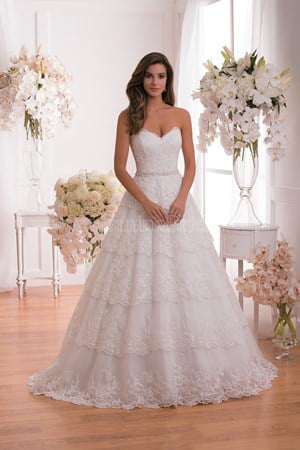
Ball gown: This dress usually features a fitted bodice and a full skirt that is usually poufy with several layers of fabric. This is the silhouette commonly associated with fairy tales and princesses and is great for rectangular and pear-shaped brides.
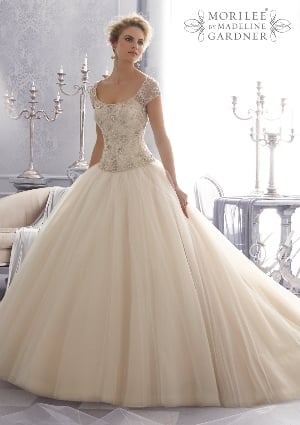
Mermaid: Also known as fit and flare, it fits closely all the way down the bodice and waist, till the knees. From here, it flares out into a layered skirt. Since it fits snugly, it is suitable for hourglass figures.

Trumpet: The trumpet is similar to the mermaid and is another fit and flare style, with a fitted bodice and body. But here, the dress flairs at mid-thigh instead of at the knee. Thus, it hides the hips and legs and is good for hourglass and rectangle-shaped brides as it emphasizes the curves.
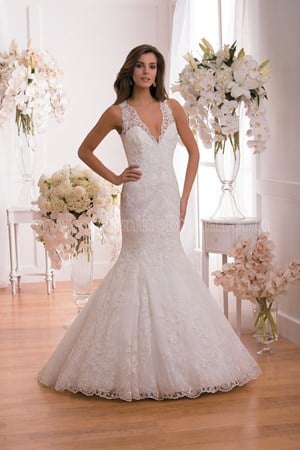
Sheath: A straight-cut dress that falls over the body frame naturally and loosely drapes the actual curves of the bride. Suitable for slim figures and hourglass brides.

To learn more about choosing a dress that suits your body shape, check out our previous post HERE.
Wedding Dress Necklines
As the name suggests, this is how the neck of the dress is designed. Popularly seen styles are listed below.
V-neckline: Seen on dresses with straps or sleeves, the neckline resembles a V that dips down in the front. It can either be deep, high, wide or small.
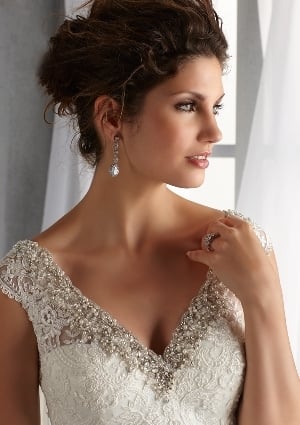
Strapless: As the name suggests, there are no straps and the neckline cuts straight across the bust.
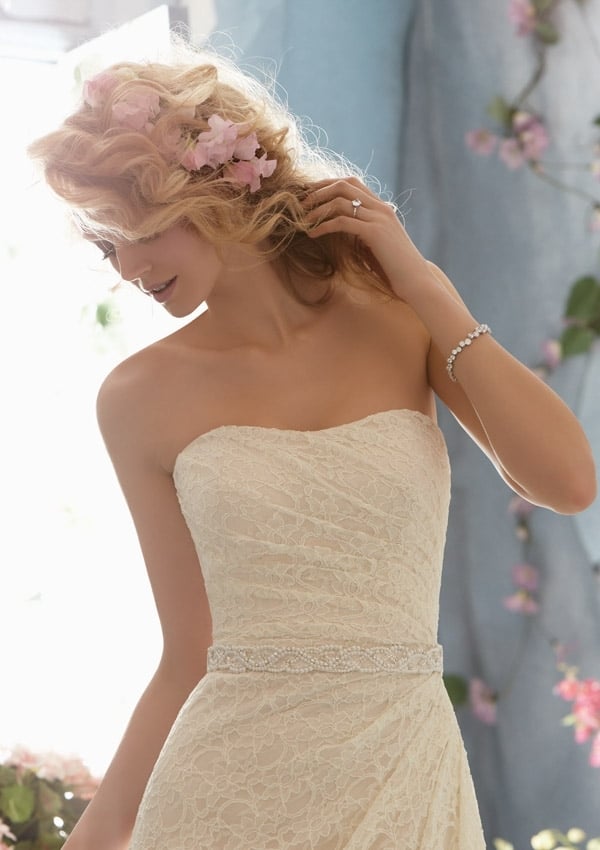
Sweetheart: A romantic version of the strapless style, this neckline gently follows the natural curves of the bust, and resembles the top of a heart. It is usually seen on dresses without sleeves, but may also be combined with sheer necklines.
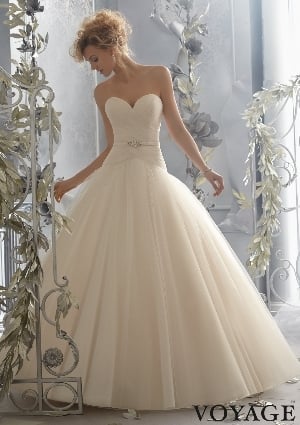
Illusion: One of the most popular styles today, the illusion features a thin layer of sheer fabric over the actual bodice. This may be embellished with beads, rhinestones or lace to create beautiful details. It offers a covering to the bust area and usually ends higher up in a round, halter or bateau style neckline.

Bateau or boat: A wide neckline that extends from one shoulder to the other, and follows the curve of the collarbone without revealing much of the decolletage.
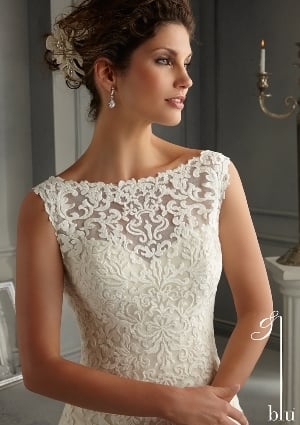
Scoop: It is U-shaped, and the depth may vary from design to design. It looks great on most brides but is particularly favourable for women with angular features.
Halter: The neckline wraps around the neck like a collar using straps that either go around the neck or are locked at the back with buttons.
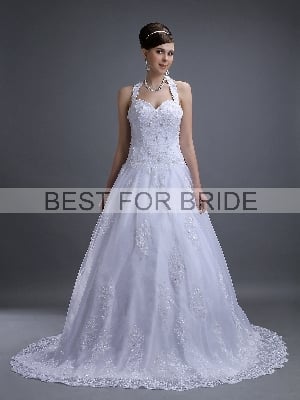
Off-the-shoulder: This neckline gently skims the shoulder on the edges, leaving the neckline and top of the shoulders exposed. It is stylish and sexy and great for showing off well-toned shoulders and necks.
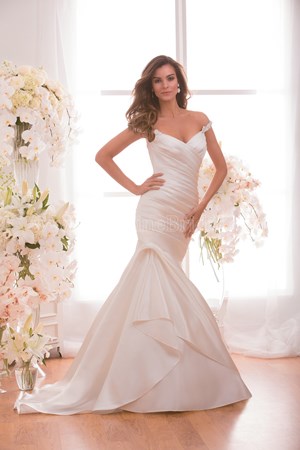
Find out more about choosing the right neckline that is best for your shape and structure, in this previous article of ours.
Wedding Dress Lengths And Train
Wedding gowns come in various lengths, varying from long and dramatic to short and stylish. There are also different train lengths to consider if you choose a traditional wedding gown. Let us look at the various options here.
Royal: Here, the length of the dress extends to 6 feet or more, from the waist. It is a very traditional style, and very dramatic.
Watteau: Here the train attaches to the dress at either the shoulders or the waist, and flows separately from the hemline.
Sweep: Can barely be considered a train at all, as it just sweeps the floor, and extends to a few inches beyond the skirt.
Chapel: Slightly longer than the sweep train, it is a train that is more obvious. Typically between 12 and 18 inches long from the hemline.
Cathedral: This is a formal train, and extends to over 20 inches along the floor. These gowns usually have to be bustled following the ceremony, or in some cases, the train may be detachable.
Ankle-length: Suitable for outdoor and casual ceremonies, the gown ends at the ankles and does not really feature a train.
Floor-length: The gown just skims the ground on all sides, and doesn’t have a train, so to say.
Ballerina: The hemline of a ballerina ends just above the ankles, and the skirt is usually very poufy and fun.
Tea-length or cocktail length: Here the gown ends near the calf, somewhat midway between knee and ankle.
Knee-length: The dress ends just below the knee and is commonly seen at casual outdoor events or those with vintage style.
Wedding Dress Fabric
The choice of fabric is important, as it makes the dress suitable for the weather at the time you are getting married, the venue and also the look you wish to portray. While some fabrics are crisp and stiff, others may be soft, flowy and breathable. These are the most popularly seen fabric choices in wedding gowns.
Tulle: Sheer fabric with a net-like appearance. Used for skirts, is rather stiff and has an open weave. This is what veils are usually made from.
Taffeta: Crisp-like tulle, but it is smooth and has a softer drape.
Satin: Soft and silky to the touch, satin is characterized by a glossy look and a very soft feel. It is heavy and has a highly reflective look.
Chiffon: Soft, semi-transparent and delicate. It drapes well and falls gently. Chiffon has a light feel and is popularly used in skirts that flow softly to the ground.
Organza: Similar to tulle, but stronger and softer. It is slightly rougher than chiffon but is crisp and sheer.
We have a detailed post on the different fabrics that are used in wedding gowns. You may like to check it out here.
Wedding Gown Waistlines
The waistline of the dress is another important element, similar to the silhouette, that can greatly alter the overall look. There are options that highlight slender waists, and also those that hide unseemly bumps in the waist area. Here are the different types available.
Natural Waistline: Here the skirt begins at the natural waist, which falls between the ribcage and the hips. It is not suitable for brides who are bulky in the stomach area. In certain dress styles, the natural waistline may be highlighted with the use of a separating element such as a sash or belt. It basically sits at the slimmest part of the torso, between the bust and the hips.
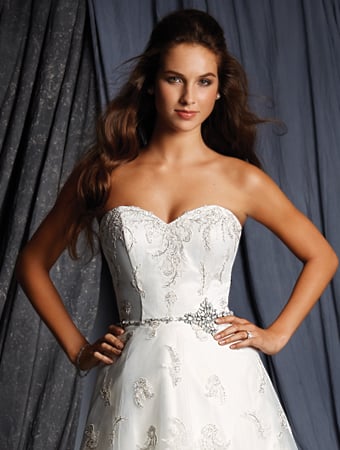
No waistline: In dresses with fit and flare styles, the waistline may not be defined at all. The dress simply follows the natural curves of the wearer all the way from the bust to the hips or knees, and that is where the skirt begins. This is usually suitable for brides with hourglass figures or those who are slender with a well-toned figure, free from unsightly bumps anywhere on the torso.
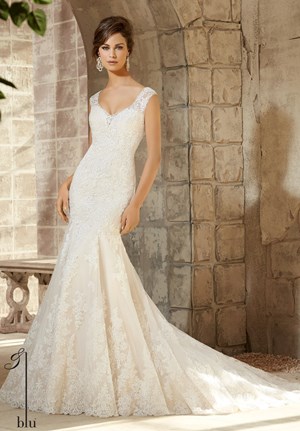
Empire Waistline: This is an elevated waistline, that begins just beneath the bust. The skirt usually flares out from just below the bust, hiding the real waistline. It is a good style for brides who wish to hide their midsection and draw attention to the bust.
Basque: This waistline is a dropped waistline shaped like a V. The dropped style looks good on short brides as it creates the illusion of length.
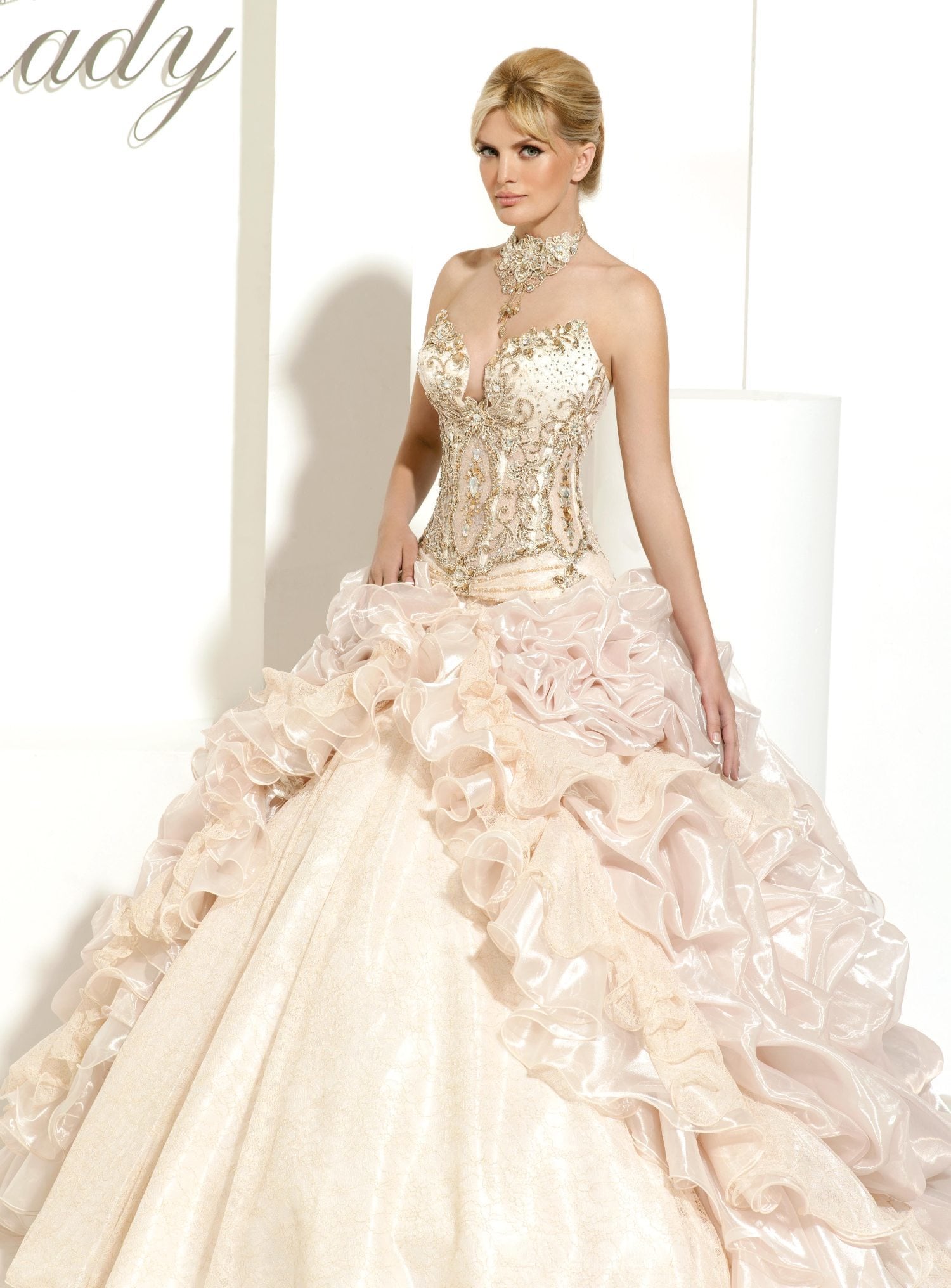
Dropped Waistline: In this style, the waistline ends several inches below the original waist. The skirt starts below this point and it may either be seen towards the center or else draping outwards towards the side in asymmetrical style wedding dresses. It elongates the torso, and so is suitable for short brides who want to create the illusion of height and a fuller figure.
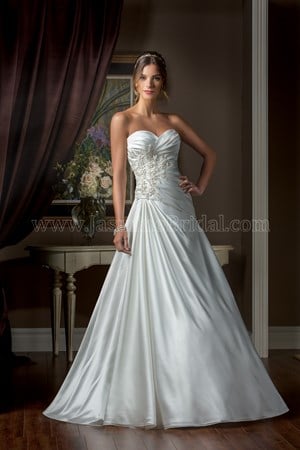
Asymmetrical Waistline: In this dress, the waistline drapes towards the side instead of the center. It can start high up, at the empire waistline height and end low in a dropped waistline fashion.

Wedding Dress Sleeves
Wedding dresses may come with sleeves or without. While the sleeveless and strapless style is quite popular among brides, Traditional brides may also choose to go with wedding dresses that usually feature sleeves. There are again several options in wedding dress sleeves, and let us look at what they are.
Sleeveless: The arms are exposed but the dress is held in place with the help of straps that go over the shoulder. The width of the straps may vary according to the design, and this will determine the support it offers the bodice.
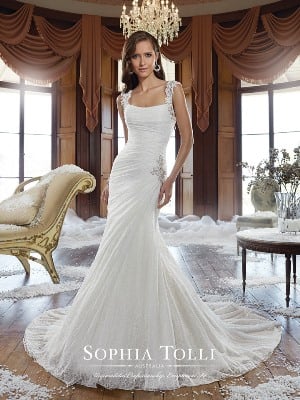
Spaghetti straps: Very thin straps frame the shoulders of the dress, and these are usually embellished with scintillating elements to add more drama. The dress resembles a strapless style, with the exception of the thin spaghetti straps on it.
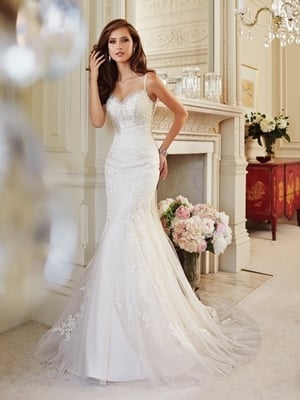
Cap Sleeves: The shortest style of sleeves, these sleeves just cover the uppermost part of the shoulder. It is stylish and modest, without looking too traditional.
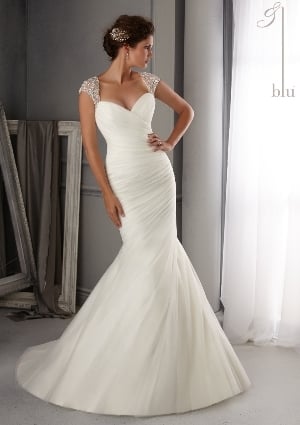
Butterfly sleeves: Short sleeves that flail and flutter beyond the shoulder and end a few inches below. It has a romantic and whimsical effect, suitable for vintage-style wedding themes.
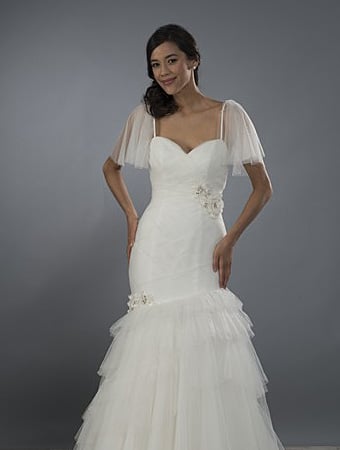
T-shirt sleeves: As the name suggests, the sleeve ends anywhere between the shoulder and the elbow and is usually fits the circumference of the arm.
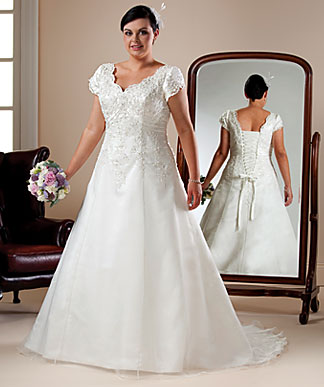
Three-fourth length sleeves: The sleeves often end below the elbow and above the wrist. It is slimming, and the sleeves are usually done in lace or illusion style to form an attractive feature on the dress.
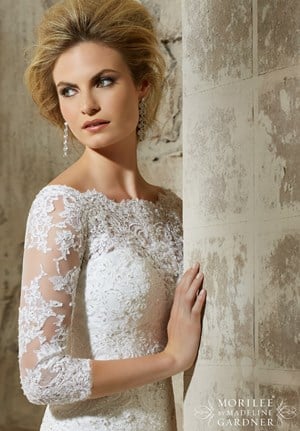
Long sleeves: The sleeves reach or extend below the wrist of the arm.
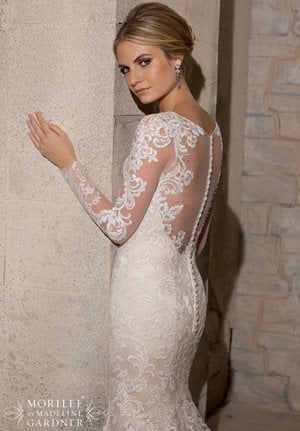
Juliet sleeves: A distinct style that is popular on the runways, these sleeves are puffed at the shoulder and then continue into a slender arm that closely fits the entire length of the bride’s arms all the way to the wrist.
Choosing the right sleeve length is imperative to determine your overall look. Many dress designers offer the option of adding custom sleeves, if the dress you choose doesn’t have the sleeve you desire. You can also consider using accessories like jackets or boleros to add the effect of sleeves if you aren’t happy with the original sleeve length of the dress.
We suggest that you take a look at this previous article to read more about selecting the right sleeve length for your wedding dress to look your best on your wedding day.
It may seem like a lot to take in initially. You needn’t study all of them, but just use this as a reference to guide you towards the dress features that you would like to look at. Browse through our online bridal gallery at Best for Bride, and you will not take too long to recognize the various terms used here. It can become interesting and fun, so do try it. For wedding dresses of all styles and sizes, visit us at Best for Bride today, and make your dream vision of being a beautiful bride come true.
Summary: Wedding Dress Lingo You Should Know
- Familiarize yourself with common wedding dress terminology to better understand the options available.
- Neckline styles include the sweetheart, V-neck, halter, and illusion necklines, each offering a different look and feel.
- Silhouette refers to the overall shape of the dress, such as A-line, ball gown, mermaid, sheath, or fit-and-flare.
- Fabric options range from traditional choices like satin, lace, and tulle to modern materials like organza and chiffon.
- Train length indicates the length of fabric extending beyond the hemline, with options like sweep, chapel, and cathedral trains.
- Bustle refers to the method of gathering and securing the train for easier movement during the reception.
- Back design can feature details like buttons, keyhole, lace-up, or open back, adding visual interest to the dress.
- Embellishments include beading, embroidery, appliques, and lace overlays, enhancing the dress with intricate details.
FAQ: Demystifying Wedding Dress Lingo Every Bride Should Know
What is the difference between an A-line and a ball gown wedding dress?
An A-line wedding dress is fitted at the bodice and gradually flares out from the waist, resembling the shape of an uppercase “A.” It is a versatile and flattering silhouette that suits most body types. On the other hand, a ball gown wedding dress has a fitted bodice and a dramatic full skirt, creating a classic princess look. It is often adorned with layers of tulle or organza, making it perfect for a fairytale-style wedding.
What does the term “mermaid” refer to in wedding dress lingo?
The term “mermaid” refers to a style of wedding dress that is fitted throughout the bodice and hips, and then flares out dramatically at or below the knee, resembling a mermaid’s tail. This silhouette is known for its glamorous and sensual appeal, accentuating the curves of the bride’s body. It is a popular choice for brides who want to make a bold and dramatic statement.
What is the significance of a sweetheart neckline in a wedding dress?
A sweetheart neckline is characterized by a gentle, curved shape resembling a heart’s top. This style accentuates the bride’s décolletage and adds a touch of romance to the overall look. It is a versatile neckline that complements various dress styles and can be paired with straps or worn as a strapless gown. The sweetheart neckline is a popular choice among brides who want to achieve a feminine and timeless appearance.
What does the term “illusion” mean in relation to wedding dresses?
In the context of wedding dresses, “illusion” refers to a type of fabric or design element that creates the illusion of bare skin while providing support and coverage. It is often used for delicate details like sleeves, bodices, or backs, where a sheer or semi-sheer material, such as lace or tulle, is used to create a see-through effect. Illusion elements can add a touch of elegance, femininity, and modernity to a wedding dress, allowing brides to showcase their personal style while maintaining modesty.
What is the difference between a chapel and a cathedral train?
A chapel train is a moderate-length train that extends about three to four feet from the waistline of the wedding dress. It adds a touch of elegance and grandeur without being overly cumbersome. On the other hand, a cathedral train is the longest type of train available, typically extending six to eight feet or more from the waistline. It creates a dramatic and regal effect, making it a popular choice for formal or traditional weddings. Brides often choose between these train lengths based on their personal preference and the formality of their wedding venue.













Obviously I’m not familiar with the terms of wedding dresses at all. Thanks so much for sharing this, It’s more than just a clue. The trumpet caught my eye, I love it. Will love to get it online but how do get to differentiate the sizes? Thanks a lot.
This is a great guide to use when getting your wedding dress online.
Ah, butterfly sleeves. I never realized that was the appropriate name for that type of dress. Thank you!
So many sexy styles for a wedding dress. How the heck do I pick one that I want to wear on the most important day of my life?
I have always had my eye on the A-line type of dress. I really just like how elegant that it looks. This is a great guide for those looking for that perfect wedding dress!